My time in Malaysia is almost at an end, but what an amazing adventure we’ve had over the past couple days! This afternoon, we returned from a two-day hiking and camping trip (with the awesome hiking group Open Sky Unlimited) out in the rainforest to the northeast of Kuala Lumpur, and I just got back from a few last hours of hiking around the city with Farahnush. I figure I might as well not even bother to sleep tonight, as I have to be up in just a couple of hours for my bus to the airport, where I’m heading to Phuket, Thailand next.
We only had one worry before our camping departure on the morning of the 2nd: would we all make it to the pickup point in time? It was another early-rising morning, as I mentioned in my last blog entry – our native Chinese-Malaysian guides, Kevin and Amos, were expecting to meet us at 7AM outside the K.L. Sentral train line in the center of town. There was a faint glimmer of the sun on the horizon when the taxi picked Farah, Christine and myself up from Cyberhomes, and when we told our driver, Solomon, that we needed to be in K.L. at 7am, he chuckled and said he would do his best. In my opinion, we were lucky to get a well-spoken and chatty taxi driver – he was a Hindu Indian himself, so he told us what it was like to live in a Muslim-majority country with a Muslim king, explained some of the laws of Malaysia, and gave us his opinion on the stunt-riding motorcycle boys we’d seen yesterday on our way down from Penang (“they’re all crazy. It’s illegal but they don’t even care – no police officer can catch them all.”)
The other three members of our party were Abu Bakr, Mohammad, and Abdush, who were a little late in finding us (hence the scare) but great company when we arrived. All three of them spoke perfect English – one had gone to school in California for awhile – and so did Kevin and Amos. Interestingly enough, I noticed right away when they took us out for breakfast that they spoke English to each other even for their personal communications, not Chinese or Bahasa Malay. Amos chuckled and grinned over the table at his friend, telling me that Kevin didn’t speak Chinese very well so they stuck to English. The place that they took us too was only a few blocks from Batu Caves, and served us delicious Rohti bread packed with all manner of great stuff, like eggs, cheese, chocolate, and bananas. I was also introduced to soft-boiled eggs (for the first time, surprisingly!) and to some hot and cold types of Malaysian sweet tea mixed with coffee.
Well fed, the eight of us were split into Amos and Kevin’s two cars and we headed out into the wilderness, driving for about an hour until we turned off of the toll highway to a much smaller (and curvier) one. “This road actually used to be the main highway before the toll roads were built. You can imagine what it was like getting stuck behind a semi truck on these!” Amos quipped to Farah and Christine and I. Once we turned onto a dirt farm road, we passed a Buddhist karma farm – a place where monks would release animals that they’d purchased from vendors in the city so that a win-win situation could play out – the Buddhists gained karma points and the animals could live out their days in safety on a farm. There was sign with Malaysian writing on it showing a shadow image of a soldier outline shooting a second, convulsing outline. “These monks are really serious about keeping their animals safe!” Christine said. Amos told us that was just the default “no trespassing” sign that stores sold… the Buddhist monks probably wouldn’t shoot you to death if you came onto their farm.
The only time we stopped on the way was so that Kevin and Amos could show the six of us a rubber tree farm up close – to my surprise, they told us that natural rubber was making a major comeback against synthetic rubber, due to the high cost of petroleum, and SE Asia was some of the best climates in the world for natural rubber trees. It was a scene not unlike the northwoods of Wisconsin – hundreds of tall, thin deciduous trees surrounding us, each with a small black tapper stuck in its side, with a bucket hooked underneath it. Kevin pointed out the lines on the trees, curving diagonally down towards the tap. “The farmer cuts a tiny section of the bark off in a diagonal way, and the rubber sap goes down the edge and drips into the pot.” There were some bits of pinkish-grey rubber all over the forest floor – it was really neat to just lean over and pick up some all natural bits of rubber, complete with chunks of dirt and bark mixed in with it.
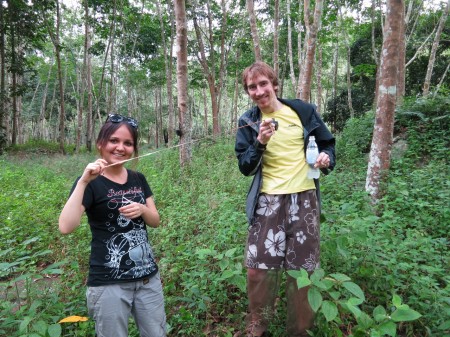
One of Christine’s pictures – Farah and I demo the stretchiness of natural rubber! You can see the black collection pots behind us
Our little caravan bounced a bit further along the muddy track until we finally came to a halt in a clearing with a few farmhouses nearby. We were told that the farmers had given our guides free reign to use a section of their land to reach the larger jungle on the other side of the river that we were about to ford over. We were quickly buckled into large hiking backpacks, and I put on some classy bug-proof pants (think of it as a wearable screen door). We hiked a little ways along a service road, surrounded by mangostein fruit trees, before descending down into the river, fording it with our packs held high above our heads to keep our sleeping bags and hammocks from getting wet.
Kevin and Amos were great guides – they were quick to tell us about what we were seeing, like the various edible and non-edible jungle berries. Dark colors are good, we were told – avoid the lighter colors. I had been snacking on dark purplish-blue berries, and as I forged ahead like a truffle-hunting hog, I called back, “what about these little blue ones?” They looked similar to what I’d been snacking on, but Amos told me that I’d get a very bad case of diarrhea if I munched on those.
Speaking of lunching, we were almost certain to get lunched on, Amos and Kevin told us. There were two main kinds of leeches in Malaysia, we were told – regular brown leeches, and tiger leeches with a long black stripe on them. They were in the water and on the forest floor, and would constantly be trying to get into our clothes. Farah and Christine, the only two ladies in our group, looked downright nervous about this, and Farah anxiously tucked her socks even more tightly into her trousers. Apparently, in a previous hike, one guy even found a leech merrily latched onto his testicles. These suckers (heh) weren’t messing around.
At least there weren’t many mosquitoes or itching, biting insects around. We were told that the mosquitoes generally stayed where the large animals were, humans included, and therefore the forest floor was pretty safe to be. My bug pants would hopefully serve just as well as leech pants.
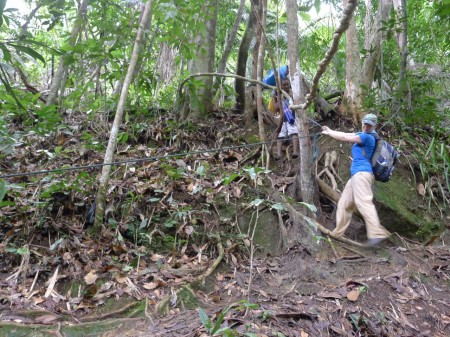
Someone had strung up some nylon cords to help hikers navigate the very steep descent down to the river
Right before we descended back down the level of the river, we passed by some huge stands of bamboo, knocked over in places by the frequent rainstorms in the jungle and splintered, exposing their razor-sharp edges to us. “Be careful as you step through here…very careful” our guides reminded us. The roar of the river had gotten steadily louder, and now we saw why – the Hammer waterfall was going to be our companion at camp. We got well-accustomed to its white-noise roar over the next day, and after dumping our bags on the beach, the other guys and I took turns leaping off of its rocky abutments into the chilly water below. Even the temperature of the air around us was perfectly comfortable, the trees around us insured that not much sunlight hit the water itself.
I was a little disappointed that the hiking part of the experience was over already, but Kevin and Amos seemed to have quite a bit to do. By the time I’d emerged from the waterfall pool to the higher level where we’d be making camp on the opposite bank, they had already strung some tarps over our eating area, built a fire, and made the au naturale toilet facilities, some 50 meters away. I helped Kevin string up my hammock for the night – not the sort of lounge-about hammocks we Americans are accustomed to seeing in backyards, mind you, but military-grade (they even had US Army printed on them!) screened sleeping enclosures with zippers on them, plus a second rain fly. He used a series of friction-based loops and some strings tied around the trees to secure everything in place, and sure enough – it worked well. I was a bit tall for it, but that’s to be expected when you’re in Asia.
Amos, meanwhile, was cooking up a batch of bamboo-smoked “tasty fish” for us. They had taken small fish filets and encased them in bamboo leaves, then stapled them shut. Each piece was about a foot long, perfect for setting over the flames between two stout logs. They were delicious, and it was fun to peel open the bamboo and use our tongues to coax the fish out from the inside. Watch out for splinters though!
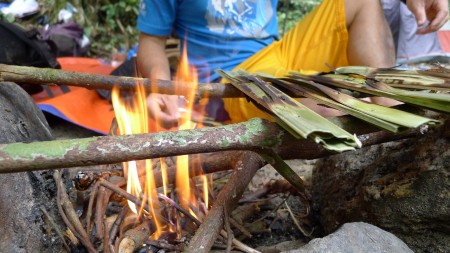
The only downside of this arrangement is when your support branches burn through and the fish land in the fire (which happened after I took over cooking)
Mohammad and Abdush, playing around in the water, had already found their first leeches on their legs, and now it was Christine’s turn. I was examining my hammock’s rain fly when I heard a muffled shout from inside the tent. Upon joining her, I saw an absolutely massive leech stuck to the inside of her lower leg – it was about as long as my finger. Remembering what the guides had told the other guys, I tickled its lower body with one finger, which caused it to curl up, detach its bloody snout from Christine’s leg, and drop onto the floor of the tent. I put it on a leaf for a moment while I got some toilet paper to stop the bleeding, but when I came back it was gone, likely speedily inch-worming its way through the underbrush while it looked for a good spot to spawn some baby leeches. I told everyone else to check their feet for bloody smears before getting into bed that night.
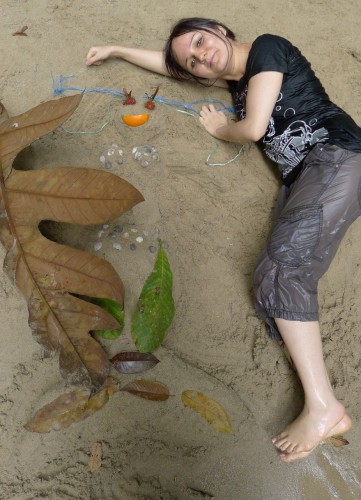
Farah poses with the “nature mermaid” that Christine maide. Check out the size of the leaf that acts as the umbrella!
Besides a bit of exploring that Farah and I did, and some sand sculptures that Christine and Farah made on the beach, it was a lazy afternoon for the six of us to just spend in our hammocks or leaping into the water. After the frantic searching for activities that we’d been doing for the past few days, Christine and I agreed that it was splendid to just relax and let our paid guides take care of everything, from the preparation to the cleanup! I had my own leech-based experience – after my hike with Farah further up the river, I returned and removed my sandals to find that no less than three leeches had taken up residence on my right foot – two small ones between my big toe and second toe, and then a massive one attached to a large vein on the side of my foot, a few inches forward from the heel. With a grimace, I yanked them off – Christine’s leech bite had taken 2 hours to stop bleeding, even with toilet paper stuck to it, so I figured there was no point in waiting.
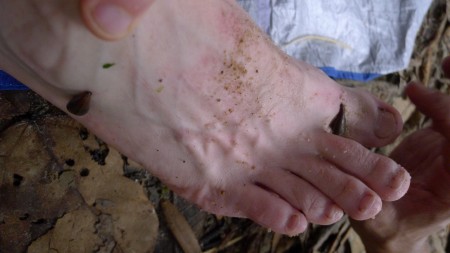
My three new friends. I’ll tell you now, the one on my ankle to the left slowly bled for for 10 straight hours – not fun. The other two weren’t as bad, but they were a lot smaller (you can barely even see one of them; he’s nestled against the other)
The guys had brought massive sacks of tasty fried rice with vegetables, and they had it ready for us as darkness started to fall around 5pm. We gathered around the campfire and the swirling smoke, growing slowly hoarse as the Hammer pounded away in the background, necessitating higher volume talking than usual. I talked religion and politics with the three Arabs, learning about their feelings on secular education and corrupt administrations, and we sang some Disney songs. It was a good night.
Although my hammock was a tight squeeze and required me to shift around a bit to find a comfortable angle that didn’t force all the blood into my head, I slept fairly well – better than I would have in a tent on the ground, that’s for sure! Amos and Kevin had more rohti for us in the morning, and lots of coffee and tea. The two of them had a very ecologically-minded view of the Hammer site, pointing out that it was used by many adventurous tourists and locals – although unfortunately it had the same problems that beautiful spots in Jordan had; with noticeable amounts of trash left by certain types of people. We packed as much of it as we could into our bags, and prepared to head out as the gibbons woke up and shouted in the trees above us. I had always thought that jungle animals would awaken with the sunrise, but apparently not. “We have a saying here,” said Amos, “that if you’re really late for work, you’re as late as a gibbon. They like to sleep in, a lot.”
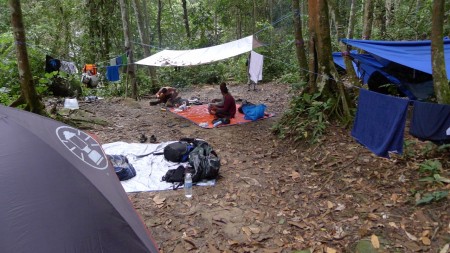
The little campsite – the tent for the Arabs in the foreground, eating in center, and the three hammocks to the right
When we made it back to the drop site where we’d left the cars and the rest of our bags the day before, Amos was surprised to see that someone had stolen the sidesteps off of his Ford pickup truck. He shook his head ruefully, saying that it was always a risk to leave things unguarded, but he’d always been lucky until now. None of the windows of either vehicle were broken though, and all of our things were okay, so the thieves had apparently gone for something easy to pry off, and left it at that.
Unfortunate thievery aside, our guides were still cheerful and took us to a Malay-Chinese restaurant that Amos knew of in a small village on the way back to the city. Although I utterly failed at using chopsticks yet again, the food was delicious and served in the communal lazy-susan way, with all of us picking and choosing between a couple fish plates, a noodle plate, a salad plate, and a beef plate. Christine loved the sour fruit drink, with a sugared, salted, and dried tamarind fruit dropped into lemon juice. Amos had one last treat for us – he stopped at a nearby fruit stand to buy fruit for his family as we were heading back to the cars, and shared a durian fruit with us. Farahnush wrinkled her nose at the sight of it, saying “that’s the one that smells like old gym socks, gross!” but I was intrigued by the cantaloupe-like smell of the small cut that the seller had put at its base for us. Despite Kevin and Amos’s playful warnings that we might regret it, Christine and I took him up on his offer of a chunk. I reached into the cut, past the sharp spikes on the outside, and pulled out a lumpy, white, flesh covered seed. It was like a cross between a pumpkin, a squash, and a cantaloupe – and it tasted absolutely horrendous, with kind of rotten pumpkin foretaste, followed by a bitter, cloying aftertaste that was kind of like mold in the mouth. Amos offered us gum immediately afterwards, and as we drove the last few kilometers back into Kulala Lumpur explained that the durian was one of the most sought after, contested, and rated fruits in Asia – a durian connoisseur was the equivalent of a wine gourmet!
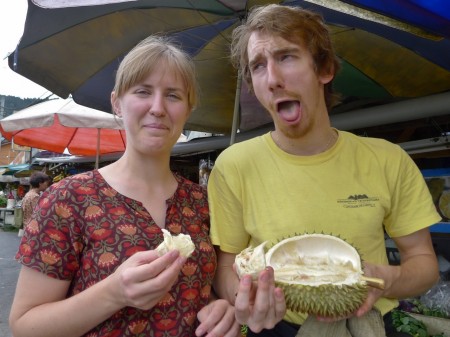
Needless to say, I don’t think we’ll be sampling more durian after this. Amos said he loved ’em, though.
We parted from our three Arab co-campers and Kevin and Amos (who put up a lot more pictures from the trip here), and Christine and I went back to K.L. Sentral to drop her off at the airport bus terminal – she’s going to be scuba diving in the Similan Islands for the next couple days, and I’ll meet up with her later. I had a bit of time to check into my hostel near the Sentral station, start writing this blog entry, and get changed from my muddy camping clothes before meeting up with Farah again for our evening of hiking the city, but as I walked back to the hostel from K.L. Sentral, I got my experience with being hit on by a possible prostitute – as I went through a small alley next to the train station, a middle-aged Thai or Filipina woman smiled at me from a corner and said, “Hello.” “Hello!” I responded back cheerfully, and continued on my way. Behind me, I heard her call out, “what a pretty boy, with such pretty blue eyes.” I didn’t turn around again, because I was already worried that I’d accidentally “led her on” or something just by saying hello to her.
After getting cleaned up, I headed out and walked a couple miles to see the Thean Hou temple, the courtyard of which at this time of the evening was almost deserted, except for a class of what I thought was yoga students – until I saw their curved samurai-style swords in incongruous duffel bags to the side of the yard! I wish I would have had more time to stay and see if they’d battle each other, but time was limited, so Farah and I took a monorail ride up to the neighborhood of Kampung Baru, an interesting area just north of the Petronas Towers. Kampung Baru doesn’t contain any monuments, statues, or noticeable shrines, but it does contain authentic small family homes and styles from a hundred years ago: Kampung Baru is a holdout against the high-rise, glass and metal commercialism that Kuala Lumpur is trying to foster, and despite being offered millions of dollars by city planners to accept towering banks and condos, they refuse to give in. More power to them.
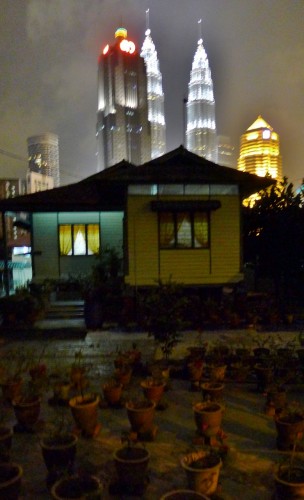
Foreground – Kampung Baru house, perhaps a flower-pot vendor. Background, only a half kilometer away…the more well-known Kuala Lumpur.
It was getting late and Farah needed to catch the last train home before midnight, but right next to the train station was a little bit of history – the original kuala lumpur, the convergence of the two rivers Gombak and Klang. The words “kuala lumpur” actually mean just that – the “muddy confluence.” There was a beautiful Moorish-style mosque on what appeared to be a triangular island, just out of reach, but it was entirely darkened and there appeared to be no quick way to reach it and try to explore the architecture within.
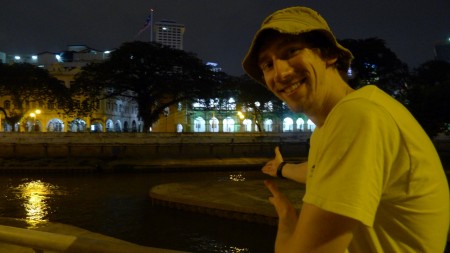
The original kuala lumpur, now unfortunate hemmed on all sides by concrete, and filled with trash. But still cool to be at the epicenter of the city.
After hugging Farah farewell at the train station, I saw the same prostitute talking earnestly with a couple of young Malaysian men near the same spot where she had been standing before. This time, I was the one to call out a loud and friendly “Hello, how are you?” to her as I passed by. The men looked at me opened-mouth, and then back at the woman. I didn’t stick around to see what happened next, but maybe she’ll be able to raise her rates a bit if she wants!
(Editor’s note: I have got to come up with a better way of doing large numbers of photographs here)
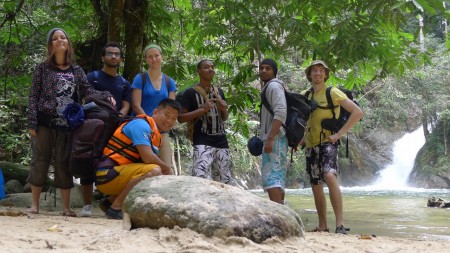
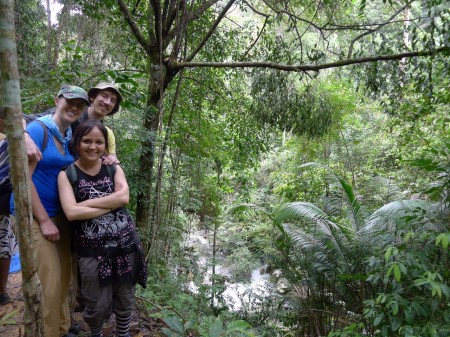
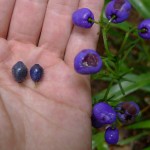
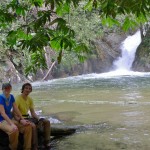
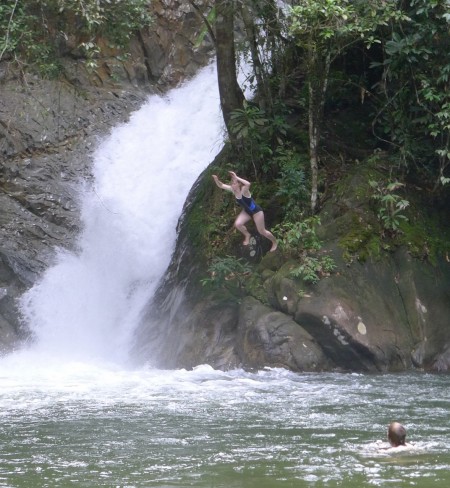
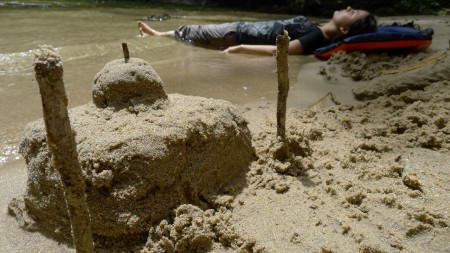
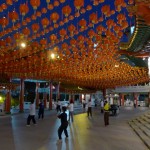


Thanks for the discrete marketing of BVMC!
Ha, no problem! But the actual reason I brought the shirt along… http://en.wikipedia.org/wiki/Royal_Flags_of_Thailand#Flag_of_the_King